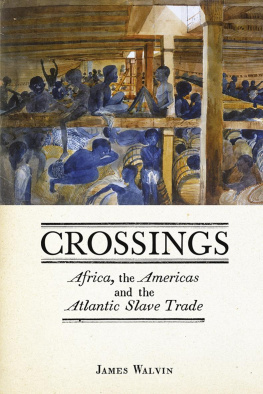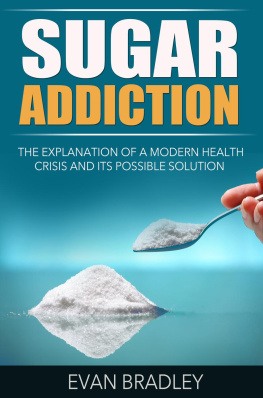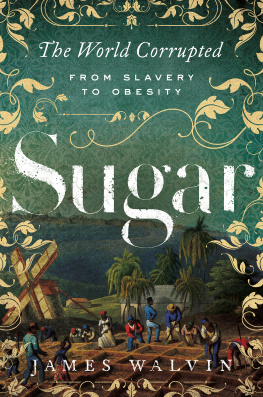
Our new grandson, Max Walvin, arrived when I found myself immersed in sugar; he quickly proved himself to be the sweetest thing of all.
This book is for him.
S WEETENING FOOD AND drink has been part of human nutritional cultures for millennia. Sweetness for its own sake, sweetness to remove the bitterness of other foods and drinks, sweetness as a medical prescription, even sweetness as a religious promise all and more have been part of human activities in countless diiferent societies. Think, too, of the way the images and ideals of sweetness have permeated English language the very words sugar, sweet and honey have, for centuries, represented some of lifes happiest moments and the most delicious sensations. How often do people call loved ones sugar or honey? Most of us can recall our very first sweetheart. And why, after marriage, and before embarking on a life together, do couples first enjoy a honeymoon? The English language fairly abounds with the vernacular and culture of sweetness, to convey the most delicate of personal feelings of love for another person to the baser instincts of bribery (a sweetener).
For many centuries, English has been replete with the language of sweetness. Middle English, for example, like the world it addressed, is littered with sweet references: to denote a loved one, a beautiful person, or someone with a good nature or disposition. Chaucer frequently uses sweet to denote affection and love. So, too, three centuries later, does Shakespeare. Moreover, both men wrote in a society only marginally affected by sugar itself. The thesaurus on the very computer I used to write these words gives the following alternatives for sweetness: lovable, cute, charming, engaging, appealing, attractive, delightful, adorable.
Today, sweetness and all that the word entails represents many of lifes great pleasures and delights. All the more curious, then, that sweetness, in the modern world, has created some of mankinds most serious personal and collective problems and dangers. Today, the desire for sweetness has become a risk to health and well-being for millions around the world.
When we think of sweetness today, we tend to think of sugar, but long before cane sugar made its seismic impact on human affairs, honey was mankinds main source of sweetness in a multitude of ancient societies. For centuries, Arabic and Persian texts, for example (in geographic, travel and cookery books), made frequent references to sweetness in contemporary cuisine and in theology. The ideal of sweetness as a delightful earthly experience a physical sensation that is pleasurable, happy and even luxurious is matched by the promise of sweetness as a reward in the hereafter. The afterlife is often represented as a sweet experience. Nor is this merely a modern Western Christian phenomenon. In a number of faiths, heavenly pleasures come in various forms of sweetness. On earth, it took the form of honey.
Rock art from 26,000 years ago, paintings from ancient Egypt and comparable evidence from ancient Indian societies, all portrayed honey as a source of local sweetness. The world of classical antiquity similarly provides an abundance of evidence about the commonplace use of honey as a sweetener, as medicine and as a symbol. The literature of the classical world (like English literature) is dotted with the imagery of honey. In The Odyssey, Homer remarked:
Never has any man passed this way in his dark vessel
and left unheard the honey-sweet music from our lips;
first he has taken his delight, then gone on his way a wiser man.
(The Odyssey, bk 12, 1. 184)
Roman texts are likewise peppered with references to honey. Lucretius noted, when writing in the first century BC, that Roman doctors used honey to persuade children to swallow foul-tasting medicines:
For as with children, when the doctors try
to give them loathsome wormwood, first they smear
sweet yellow honey on the goblets rim.
(De Rerum Natura, bk 1, 1. 936)
More familiar perhaps, the Holy Bible has a profusion of images of honey. When the Lord led the Israelites out of Egypt, he led them to a land flowing with milk and honey (Exodus, Ch. 3, v. 8). And the Old Testament, too, has numerous references to honey; the Promised Land, for instance, comes with milk and honey blessed.
Honey was offered as a tribute to the gods in ancient Egypt and classical Greece, and has importance, too, in Hinduism. Many ancient societies had time-honoured religious rituals using honey: placing a drop of honey on the lips of a newborn child; a piece of apple dipped in honey on a Jewish childs first day at school; and honey cake augurs good fortune when served on the Jewish New Year. All this is in addition to the enduring theme of honey, honey-making and bees in literature from the most ancient of recorded societies, right down to relatively modern English texts:
Stands the Church clock at ten to three?
And is there honey still for tea?
(Rupert Brookes, from The Old
Vicarage, Grantchester, 1916)
Honey has, then, long been both symbol and sweetener. For centuries, it was a feature of medicine and pharmacology. From ancient China and India, to classical Greece and throughout the world of Islam, honey was prescribed as medicine for a host of maladies. Like cane sugar later, honey when mixed with other ingredients produced medicines prescribed by Islamic and medieval doctors. To this day, it continues to be used as medication in a number of communities that have remained relatively untouched by modern medicine, and also in a variety of alternative treatments which have recently found favour the world over.
All this was in addition to the more obvious role played by honey as a sweetener in various cuisines. Sweet foods were (and are) especially valued in Islamic societies, partly because the Prophet liked honey and recommended it as a medicine. Even after the coming of cane sugar, sweet foods, especially desserts made with honey, have retained a special place in Islamic societies and maintain their importance in a number of ceremonies and practices.
Honey remains an important element in Islamic life. The Koran makes regular comments on sweetness: To enjoy sweets is a sign of faith... Yet even before the rise of Islam, we know that honey had been used for a number of culinary and spiritual purposes: for nutrition, as medicine, and as a promise of future happiness.
* * *
Honey, then, had an importance and significance in a large number of ancient civilisations. It was a food in its own right and a customary ingredient in recipes and menus. But it also represented purity and morality. Both the Bible and the Koran depicted an afterlife rich in much-valued food and drink milk, wine and honey. Mundane earthly matters were also scattered with honey. We know, for example, of more than three hundred recipes from the eighth to ninth centuries which have come down to us in the form of The Baghdad Cookbook (the highest level of PersoIslamic cuisine), although many were inherited from much earlier societies. About one third of those dishes and drinks are sweetened, such as doughnuts, fritters, pancakes, rice dishes, sherbets and other drinks.
These tastes, and the culture of Islamic cuisine and food, travelled on the back of Islam itself as it expanded throughout what is now the Middle East and the Gulf, across North Africa, into sub-Saharan Africa and into southern Europe. Naturally enough, the cultures and habits of Islamic peoples, including their cuisine and their foodstuffs, went with them. They carried with them a taste for honey
Next page













